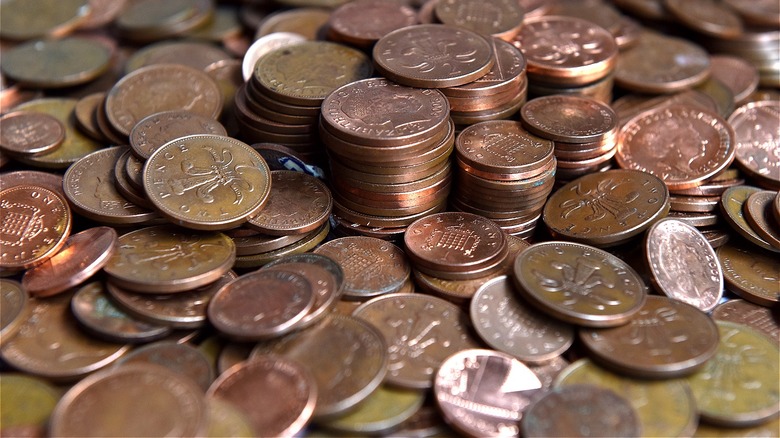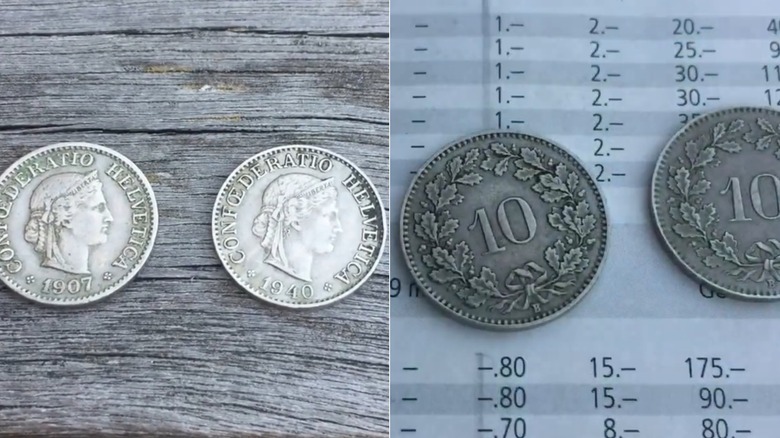The Oldest Coin In Circulation
Currency has existed in coin form since the days of the ancients — but not all old coins are on display in a museum. Some old coins are still being used as legal tender today. Before you start digging around your couch cushions for a Buffalo nickel, Aldi quarter, or any other valuable coins you might have lying around, just know that the oldest coin in circulation today is no American girl — but a Swiss miss.
Swiss banks are famous for their secrecy, but a very public fact about Swiss currency brings new meaning to the term "old money." In 2021, the Guiness Book of World Records named Switzerland's 10 centimes coin, minted since 1879 by Switzerland's Federal Mint (Swissmint) as the "oldest coin design still in circulation."
This doesn't mean that the modern-day Swiss pay for their fondue and chocolate with coins from the 1800s, of course — though we hope at least one person has tried. The distinction comes from the fact that the coin's design hasn't changed at all since its first minting, aside from years of issue printed throughout the years. This small denomination of the Swiss Franc is rich in historical value — even if it's only worth about 10 cents American.
The coin's design
The design for Switzerland's 10 centimes coin (the oldest in circulation) was created by Karl Schwenzer in 1879. Schwenzer was no newbie to coin design at this time, but had served as the royal court medalist (or coin artist) for the then-German state, the Kingdom of Württemberg.
Working for Switzerland, Schwenzer created a design that features Liberty's head in right-facing profile on the obverse (or heads) side of the coin, surrounded by the phrase "CONFŒDERATIO HELVETICA." On the reverse (or tails) side, the 10 centimes coin bears the number "10" wreathed by the leaves of two oak branches, tied together at their base with a ribbon. While briefly made with pure nickel from 1932-39 (like the penny was made of pure copper at first), the coin has primarily been made of cupronickel, a copper-nickel alloy known for its resistance to corrosion and its high melting point. (Learn why the penny costs more to make today than it's worth.)
Liberty, meanwhile, with her braided hair and diadem, is yet another interpretation of Libertas, the Roman goddess of freedom; she appears on most Swiss coins. "CONFŒDERATIO HELVETICA" is the Latin name for the Swiss Confederation. The oak branches symbolize strength, and the tiny "B" embossed just underneath where the branches are tied together represents Bern, the Swiss capital city where the coins are minted. (Also see Money Digest's explainer on the symbols on the $1 bill.)
The coin's history
Switzerland is a landlocked empire of mountains, watches, and chocolate. Due to its diverse borders, Switzerland boasts four national languages: French, German, Italian, and Romansh. The west-central European country is famous for its skiing, lakes, and long-held stance of military neutrality. In fact, Switzerland has always been slow to unify, whether with the world at large — or within its own 26 cantons, or member states.
After spending much of its existence operating on a series of alliances between the self-governing cantons, Switzerland was rocked by French invasion during the Napoleonic Wars. Even after Napoleon's fall, intercantonal divisions raged, culminating with some light Swiss civil war in 1847. By 1848, unity was looking good to the Swiss. The country re-established itself as a federal state, and established a single currency in 1850 (via the Swiss Journal of Economics and Statistics). That currency — and its exclusive federal mint in Bern as of 1853 (via Swissmint) — would be used as the bedrock for a new, united Switzerland.
You might not be able to wield much purchasing power in modern-day Switzerland if you have only a few 10 centimes coins to rub together, but you'll be holding a wealth of historical symbolism. The coin is the oldest design in circulation, and represents the unification of Switzerland through a central federal government and the expansion of democratic practices, as well as Switzerland's modern-day identity as a center for wealth, tourism, and economic growth. Not bad for a coin that might only be able to help you buy a candy bar.


